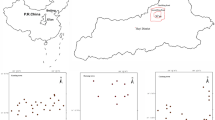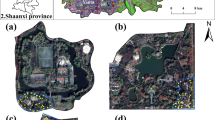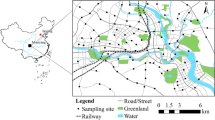Abstract
Sixty-two topsoil samples were collected within the third ring road of Xi’an City in Northwest China and analyzed by X-ray fluorescence spectrometry for the concentrations of As, Ba, Co, Cr, Cu, Mn, Ni, Pb, V, and Zn. The pollution levels of trace metals were assessed by pollution index (PI) and Nemerow pollution index (NPI). Meanwhile, the sources of trace metals were apportioned by receptor models, including positive matrix factorization (PMF), UNMIX, and principal component analysis–multiple linear regression (PCA–MLR). The average concentrations of the trace metals analyzed in the urban soil exceeded the corresponding soil element background values of Shaanxi Province, especially for Co, which was 2.38 times higher than the corresponding background value. The mean of PI was 2.38 for Co, reflecting a moderate pollution level, and ranged from 1.07 to 1.72 for other trace metals, presenting slight pollution levels. The NPI of trace metals varied between 1.20 and 3.50 with an average of 2.00, indicating that trace metals presented slight pollution in 62.90% of soil samples, moderate pollution in 30.65% of soil samples, and heavy pollution in 6.45% of soil samples, respectively. Three sources of trace metals apportioned by the three receptor models were mixed nature and anthropogenic source, traffic exhaust, and industrial emissions. The contributions of them were 38.58%, 32.72%, and 28.70% from the PMF, 65.36%, 17.76%, and 16.88% through the UNMIX and 49.16%, 38.90%, and 11.94% via the PCA–MLR, respectively. Meanwhile, the study results suggested that the combined usage of multiple receptor models is a good method to apportion the source compositions and contributions of trace metals in urban soil.






Similar content being viewed by others
References
Adamiec E, Jarosz-Krzemińska E, Wieszała R (2016) Heavy metals from non-exhaust vehicle emissions in urban and motorway road dusts. Environ Monit Assess 188:369
Ahmed F, Fakhruddin ANM, Imam MDT, Khan N, Khan TA, Rahman MM, Abdullah ATM (2016) Spatial distribution and source identification of heavy metal pollution in roadside surface soil: a study of Dhaka Aricha highway, Bangladesh. Ecol Process 5:2
Al-Khashman OA (2007) Determination of metal accumulation in deposited street dusts in Amman, Jordan. Environ Geochem Health 29:1–10
Alves RIS, Sampaio CF, Nadal M, Schuhmacher M, Domingo JL, Segura-Muñoz SI (2014) Metal concentrations in surface water and sediments from Pardo River, Brazil: human health risks. Environ Res 133:149–155
Arditsoglou A, Samara C (2005) Levels of total suspended particulate matter and major trace elements in Kosovo: a source identification and apportionment study. Chemosphere 59:669–678
Bhuiyan MAH, Dampare SB, Islam MA, Suzuki S (2015) Source apportionment and pollution evaluation of heavy metals in water and sediments of Buriganga River, Bangladesh, using multivariate analysis and pollution evaluation indices. Environ Monit Assess 187:4075
Bi CJ, Zhou Y, Chen ZL, Jia JP, Bao XY (2018) Heavy metals and lead isotopes in soils, road dust and leafy vegetables and health risks via vegetable consumption in the industrial areas of Shanghai, China. Sci Total Environ 619:1349–1357
Burges A, Epelde L, Garbisu C (2015) Impact of repeated single-metal and multi-metal pollution events on soil quality. Chemosphere 120:8–15
Callén MS, de la Cruz MT, López JM, Navarro MV, Mastral AM (2009) Comparison of receptor models for source apportionment of the PM10 in Zaragoza (Spain). Chemosphere 76:1120–1129
Cao HB, Chao SH, Qiao L, Jiang YX, Zeng XC, Fan XT (2017) Urbanization-related changes in soil PAHs and potential health risks of emission sources in a township in Southern Jiangsu, China. Sci Total Environ 575:692–700
Chen XD, Lu XW (2018) Pollution characteristics and source apportionment of heavy metals in topsoil from an area in Xi’an city, China. Ecotoxicol Environ Saf 151:153–160
Chen XD, Lu XW, Li LY, Yang G (2013) Spatial distribution and contamination assessment of heavy metals in urban topsoil from inside the Xi’an second ringroad, NW China. Environ Earth Sci 68:1979–1988
Chen H, Lu XW, Chang YY, Xue WZ (2014) Heavy metal contamination in dust from kindergartens and elementary schools in Xi’an, China. Environ Earth Sci 71:2701–2709
Chen HY, Teng YG, Chen RH, Li J, Wang JS (2016a) Contamination characteristics and source apportionment of trace metals in soils around Miyun reservoir. Environ Sci Pollut Res 23:15331–15342
Chen HY, Teng YG, Lu SJ, Wang YY, Wu J, Wang JS (2016b) Source apportionment and health risk assessment of trace metals in surface soils of Beijing metropolitan, China. Chemosphere 144:1002–1011
CNEMC (China National Environmental Monitoring Centre) (1990) The background values of Chinese soils. Environmental Science Press of China, Beijing, pp 15–505
De Miguel E, Llamas JF, Chacón E, Berg T, Larssen S, Røyset O, Vadset M (1997) Origin and patterns of distribution of trace elements in street dust: unleaded petrol and urban lead. Atmos Environ 31:2733–2740
De Silva S, Ball AS, Huynh T, Reichman SM (2016) Metal accumulation in roadside soil in Melbourne, Australia: effect of road age, traffic density and vehicular speed. Environ Pollut 208:102–109
Dong B, Zhang RZ, Gan YD, Cai LQ, Freidenreich A, Wang KP, Guo TW, Wang HB (2019) Multiple methods for the identification of heavy metal sources in cropland soils from a resource-based region. Sci Total Environ 651:3127–3138
Dung TTT, Cappuyns V, Swennen R, Phung NK (2013) From geochemical background determination to pollution assessment of heavy metals in sediments and soils. Rev Environ Sci Biotechnol 12:335–353
Duzgoren-Aydin NS (2007) Sources and characteristics of lead pollution in the urban environment of Guangzhou. Sci Total Environ 385:182–195
Facchinelli A, Sacchi E, Mallen L (2001) Multivariate statistical and GIS based approach to identify heavy metal sources in soils. Environ Pollut 114:313–324
Fu J, Zhao C, Luo Y, Liu C, Kyzas GZ, Luo Y, Zhao DY, An SQ, Zhu HL (2014) Heavy metals in surface sediments of the Jialu River, China: their relations to environmental factors. J Hazard Mater 270:102–109
Henry RC (1997) History and fundamentals of multivariate air quality receptor models. Chemom Intell Lab Syst 37:37–42
Henry RC (2003) Multivariate receptor modeling by N-dimensional edge detection. Chemom Intell Lab Syst 65:179–189
Henry RC, Christensen ER (2010) Selecting an appropriate multivariate source apportionment model result. Environ Sci Technol 44:2474–2481
Hopke PK (2003) Recent developments in receptor modeling. J Chem 17:255–265
Jaffar STA, Luo F, Ye R, Younas H, Hu XF, Chen LZ (2017) The extent of heavy metal pollution and their potential health risk in topsoils of the massively urbanized district of Shanghai. Arch Environ Contam Toxicol 73:362–376
Jaradat Q, Momani K (1999) Contamination of roadside soil, plants and air with heavy metals in Jordan. A comparative study. Turk J Chem 23:209–220
Jiang YX, Chao SH, Liu JW, Yang Y, Chen YJ, Zhang AC, Cao HB (2017) Source apportionment and health risk assessment of heavy metals in soil for a township in Jiangsu Province, China. Chemosphere 168:1658–1668
Ke L, Liu W, Wang YW, Russell AG, Edgerton ES, Zheng M (2008) Comparison of PM2.5 source apportionment using positive matrix factorization and molecular marker-based chemical mass balance. Sci Total Environ 394:290–302
Khademi H, Gabarrón M, Abbaspour A, Martinez-Martínez S, Faz A, Acosta JA (2019) Environmental impact assessment of industrial activities on heavy metals distribution in street dust and soil. Chemosphere 217:695–705
Khorshid MSH, Thiele-Bruhn S (2016) Contamination status and assessment of urban and non-urban soils in the region of Sulaimani City, Kurdistan, Iraq. Environ Earth Sci 75:1171
Kim E, Hopke PK (2007) Comparison between sample-species specific uncertainties and estimated uncertainties for the source apportionment of the speciation trends network data. Atmos Environ 41:567–575
Lang YH, Yang W (2014) Source apportionment of PAHs using UNMIX model for Yantai costal surface sediments, China. Bull Environ Pollut Toxicol 92:30–35
Lang YH, Yang X, Wang H, Yang W, Li GL (2013) Diagnostic ratios and positive matrix factorization to identify potential sources of PAHs in sediments of the Rizhao offshore, China. Polycycl Aromat Compd 33:161–172
Lang YH, Li GL, Wang XM, Peng P (2015) Combination of UNMIX and PMF receptor model to apportion the potential sources and contributions of PAHs in wetland soils from Jiaozhou Bay, China. Mar Pollut Bull 90:129–134
Larsen RK, Baker JE (2003) Source apportionment of polycyclic aromatic hydrocarbons in the urban atmosphere: a comparison of three methods. Environ Sci Technol 37:1873–1881
Li X (2015) Levels and spatial distribution of heavy metals in urban dust in China. Acta Geochim 34:498–506
Li XP, Feng LN (2010) Spatial distribution of hazardous elements in urban topsoils surrounding Xi’an industrial areas, (NW China): controlling factors and pollution assessments. J Hazard Mater 174:662–669
Li ZY, Ma ZW, van der Kuijp TJ, Yuan Z, Huang L (2014) A review of soil heavy metal pollution from mines in China: pollution and health risk assessment. Sci Total Environ 468:843–853
Lu XW, Wang LJ, Lei K, Huang J, Zhai YX (2009) Pollution assessment of copper, lead, zinc, manganese and nickel in street dust of Baoji, NW China. J Hazard Mater 161:1058–1062
Lu XW, Wang LJ, Li LY, Lei K, Huang L, Kang D (2010) Multivariate statistical analysis of heavy metals in street dust of Baoji, NW China. J Hazard Mater 173:744–749
Lu XW, Wu X, Wang YW, Chen H, Gao PP, Fu Y (2014a) Risk assessment of toxic metals in street dust from a medium-sized industrial city of China. Ecotoxicol Environ Saf 106:154–163
Lu XW, Zhang XL, Li LY, Chen H (2014b) Assessment of metals pollution and health risk in dust from nursery schools in Xi’an, China. Environ Res 128:27–34
Luo XS, Xue Y, Wang YL, Cang L, Xu B, Ding J (2015) Source identification and apportionment of heavy metals in urban soil profiles. Chemosphere 127:152–157
Manousakas M, Papaefthymiou H, Diapouli E, Migliori A, Karydas AG, Bogdanovic-Radovic I, Eleftheriadis K (2017) Assessment of PM2.5 sources and their corresponding level of uncertainty in a coastal urban area using EPA PMF 5.0 enhanced diagnostics. Sci Total Environ 574:155–164
Manta DS, Angelone M, Bellanca A, Neri R, Sprovieri M (2002) Heavy metals in urban soils: a case study from the city of Palermo (Sicily), Italy. Sci Total Environ 300:229–243
Men C, Liu RM, Xu F, Wang QR, Guo LJ, Shen ZY (2018) Pollution characteristics, risk assessment, and source apportionment of heavy metals in road dust in Beijing, China. Sci Total Environ 612:138–147
Nagarajan R, Jonathan MP, Roy PD, Prasanna MV, Elayaraja A (2014) Enrichment pattern of leachable trace metals in roadside soils of Miri City, Eastern Malaysia. Environ Earth Sci 72:1765–1773
Norris G, Duvall R (2014) EPA positive matrix factorization (PMF) 5.0 fundamentals and user guide (EPA/600/R-14/108). US EPA
Norris G, Vedantham R, Duvall R (2007) EPA Unmix 6.0 fundamentals and user guide. US Environmental protection Agency, Research Triangle Park, NC
Ostro B, Feng WY, Broadwin R, Green S, Lipsett M (2007) The effects of components of fine particulate air pollution on mortality in California: results from CALFINE. Environ Health Perspect 115:13–19
Paatero P, Tapper U (1994) Positive matrix factorization: a non-negative factor model with optimal utilization of error estimates of data values. Environmetrics 5:111–126
Parra S, Bravo MA, Quiroz W, Moreno T, Karanasiou A (2014) Source apportionment for contaminated soils using multivariate statistical methods. Chemom Intell Lab Syst 138:127–132
Raja R, Nayak AK, Rao KS, Puree C, Shahid M, Panda BB, Kumar A, Tripathi R, Bhattacharyya P, Baig MJ, Lal B, Mohanty S, Gautam P (2014) Effect of fly ash deposition on photosynthesis, growth and yield of rice. Bull Environ Pollut Toxicol 93:106–112
Rajaram BS, Suryawanshi PV, Bhanarkar AD, Rao CVC (2014) Heavy metals pollution in road dust in Delhi City, India. Environ Earth Sci 72:3929–3938
Saeedi M, Li LY, Salmanzadeh M (2012) Heavy metals and polycyclic aromatic hydrocarbons: pollution and ecological risk assessment in street dust of Tehran. J Hazard Mater 227–228:9–17
Sawut R, Tiyip T, Abliz A, Kasim N, Nurmemet I, Sawut M, Tashpolat N, Ablimit A (2017) Using regression model to identify and evaluate heavy metal pollution sources in an open pit coal mine area, Eastern Junggar, China. Environ Earth Sci 76:822
Shi GL, Zeng F, Li X, Feng YC, Wang YQ, Liu GX, Zhu T (2011) Estimated contributions and uncertainties of PCA/MLR–CMB results: source apportionment for synthetic and ambient datasets. Atmos Environ 45:2811–2819
Soclo HH, Garrigues P, Ewald M (2000) Origin of polycyclic aromatic hydrocarbons (PAHs) in coastal marine sediments: case studies in Cotonou (Benin) and Aquitaine (France) areas. Mar Pollut Bull 40:387–396
Sofowote UM, Mccarry BE, Marvin CH (2008) Source apportionment of PAH in Hamilton Harbour suspended sediments: comparison of two factor analysis methods. Environ Sci Technol 42:6007–6014
Stout SA, Graan TP (2010) Quantitative source apportionment of PAHs in sediments of Little Menomonee River, Wisconsin: weathered creosote versus urban background. Environ Sci Technol 44:2932–2939
Tang JY, Zhang JC, Ren LH, Zhou YY, Gao J, Luo L, Yang Y, Peng QH, Huang H, Chen AW (2019) Diagnosis of soil contamination using microbiological indices: a review on heavy metal pollution. J Environ Manag 242:121–130
Thurston GD, Spengler JD (1985) A quantitative assessment of source contributions to inhalable particulate matter pollution in Metropolitan Boston. Atmos Environ 19:9–25
Tian YZ, Shi GL, Han SQ, Zhang YF, Feng YC, Liu GR, Gao LJ, Wu JH, Zhu T (2013) Vertical characteristics of levels and potential sources of water-soluble ions in PM10 in a Chinese megacity. Sci Total Environ 447:1–9
Wang LJ, Lu XW, Ren CH, Li XX, Chen CC (2014) Contamination assessment and health risk of heavy metals in dust from Changqing industrial park of Baoji, NW China. Environ Earth Sci 71:2095–2104
Wang JH, Li SW, Cui XY, Li HM, Qian X, Wang C, Sun YX (2016a) Bioaccessibility, sources and health risk assessment of trace metals in urban park dust in Nanjing, Southeast China. Ecotoxicol Environ Saf 128:161–170
Wang LJ, Wang L, Tao WD, Richard CS, Shi XM, Lu XW (2016b) Characteristics, sources, and health risk of polycyclic aromatic hydrocarbons in urban surface dust: a case study of the city of Xi′an in Northwest China. Environ Sci Pollut Res 23:13389–13402
Wang YH, Huang QH, Lemckert C, Ma Y (2017) Laboratory and field magnetic evaluation of the heavy metal contamination on Shilaoren Beach, China. Mar Pollut Bull 117:291–301
Wang LJ, Liu MM, Tao WD, Zhang WJ, Wang L, Shi XM, Lu XW, Li XP (2018a) Pollution characteristics and health risk assessment of phthalate esters in urban soil in the typical semi-arid city of Xi’an, Northwest China. Chemosphere 191:467–476
Wang LJ, Tao WD, Richard CS, Xu X, Lu XW (2018b) Speciation, sources and risk assessment of heavy metals in suburban vegetable garden soil of Xianyang City, Northwest China. Front Earth Sci 12:397–407
XAMBS (Xi’an Municipal Bureau of Statistics) (2017) Xi'an Statistical Yearbook in 2017. China Statistics Press, Beijing (Chinese)
Xue JL, Zhi YY, Yang LP, Shi JC, Zeng LZ, Wu LS (2014) Positive matrix factorization as source apportionment of soil lead and cadmium around a battery plant (Changxing County, China). Environ Sci Pollut Res 21:7698–7707
Yang B, Zhou LL, Xue ND, Li FS, Li YW, Rolf DV, Cong X, Yan YZ, Liu B (2013) Source apportionment of polycyclic aromatic hydrocarbons in soils of Huanghuai Plain, China: comparison of three receptor models. Sci Total Environ 443:31–39
Yu WW, Liu RM, Xu F, Men C, Shen ZY (2016) Identifications and seasonal variations of sources of polycyclic aromatic hydrocarbons (PAHs) in the Yangtze River Estuary, China. Mar Pollut Bull 104:347–354
Zhang Y, Guo CS, Xu J, Tian YZ, Shi GL, Feng YC (2012) Potential source contributions and risk assessment of PAHs in sediments from Taihu Lake, China: comparison of three receptor models. Water Res 46:3065–3073
Zhang YQ, Cao SZ, Xu XY, Qiu J, Chen MX, Wang D, Guan DH, Wang CY, Wang X, Dong BW, Huang H, Zhao N, Jin L, Bai YN, Duan XL, Liu Q, Zhang YW (2016) Metals compositions of indoor PM2.5, health risk assessment, and birth outcomes in Lanzhou, China. Environ Monit Assess 188:325
Zhang J, Hua P, Krebs P (2017) Influences of land use and antecedent dry-weather period on pollution level and ecological risk of heavy metals in road-deposited sediment. Environ Pollut 228:158–168
Zhao HT, Li XY (2013) Risk assessment of metals in road-deposited sediment along an urban–rural gradient. Environ Pollut 174:297–304
Zhong LY, Liu L, Yang JW (2012) Characterization of heavy metal pollution in the paddy soils of Xiangyin County, Dongting lake drainage basin, central south China. Environ Earth Sci 67:2261–2268
Zhu ZM, Sun GY, Bi XY, Li ZG, Yu GH (2013) Identification of trace metal pollution in urban dust from kindergartens using magnetic, geochemical and lead isotopic analyses. Atmos Environ 77:9–15
Acknowledgements
This research was supported by the National Natural Science Foundation of China through Grants 41877516 and 41877517, and the Fundamental Research Funds for the Central Universities through Grants GK201701010 and GK201601009.
Author information
Authors and Affiliations
Corresponding author
Rights and permissions
About this article
Cite this article
Zhang, S., Wang, L., Zhang, W. et al. Pollution Assessment and Source Apportionment of Trace Metals in Urban Topsoil of Xi’an City in Northwest China. Arch Environ Contam Toxicol 77, 575–586 (2019). https://doi.org/10.1007/s00244-019-00651-8
Received:
Accepted:
Published:
Issue Date:
DOI: https://doi.org/10.1007/s00244-019-00651-8




